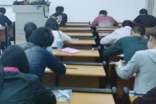- 相关推荐
2006年职称英语考试卫生类(B级)试题及答案(4)
第5部分:补全短文(第46~50题,每题2分,共10分)下面的短文有5处空白,短文后有6个句子,其中5个取自短文,请根据短文内容将其分别放回原有位置,以恢复文章原貌。

Female Bullfighting
It was a unique, eye-catching sight: an attractive woman in a shiny bullfighter#39;s suit, sword in hand, facing the sharp horns of a black, 500-kilograrn beast.
Most people thought the days of female bullfighting were over in Spain(46)
The first woman fighter, Cristina Sanchez, quit in 1999 because of male discrimination (歧视)。 But Vega is determined to break into what could be Spain#39;s most resistant male field.(47)
Spanish women have conquered almost all male professions(48) "The bull does not ask for your identity card," she said in an interview a few years ago, She insisted that she be judged for her skills rather than her femaleness.
Vega became a matador (斗牛士) in 1997 in the southwestern city of Caceres(49) She entered a bullfighting school in Malaga at age nine and performed her first major bullfight at age 14. She has faced as much opposition as Sanchez did. And
the "difficulties have made her grow into a very strong bullfighter," her brother Jorge says The 1.68-metre tall and somewhat shy Vega says her love of bullfighting does not make her any less of a woman(50)
A She intends to become even better than Sanchez was
B Her father was an aspiring (有雄心壮志的) bullfighter.
C But many bullfighting professionals continue to insist that women do not have what it takes to perform the country#39;s "national show"
D "I#39;m a woman from head to toe and proud of it," she once said.
E She looks like a male bullfighter.
F But recently, 29-year-old Mari Paz Vega became the second woman in Spanish history to fight against those heavy animals
第6部分:完形填空(第51~65题,每题1分,共15分)
下面的短文有15处空白,请根据短文内容为每处空白确定1个最佳选项。Staying
Active in Old Age Keeps People Mobile
People over 70 who aren#39;t active are more likely to develop problems walking or climbing stairs within a few years, according to a new study.
These findings suggest that it#39;s very important to stay (51) in old age, study author Dr. Marjolein Visser told Reuters Health.
"Physical activity in old age is as important(52) taking your medications(药物)," Visser noted. "You do not need to join an expensive, fancy sports club with high-tech (高科技的) equipment. Your body will already(53) from regular walking."
Visser, a Dutch (荷兰的)scholar,explained that(54) active helps prevent people from becoming breathless during simple activities, increase muscle mass and strength, and maintain the balance people need to walk up stairs, for instance.
To investigate how important exercise is to older adults, Visser#39;s team interviewed 3,075 men and (55) between the ages of 70 and 79, all of whom said they had no problems walking one-quarter of a mile or climbing (56). The investigators followed the subjects for 4-1/2 years, noting who developed problems (57) and climbing stairs.
During the study, 34 percent of men and 47 (58) of women said they began to struggle with walking and climbing stairs. People (59) were inactive were twice as likely to report these problems as people who said they got regular exercise.
People who didn#39;t exercise but had active lifestyles appeared to be at a somewhat higher risk of developing (60) walking and climbing stairs, relative to people who exercised (61)。 Still,leading an active lifestyle appeared to protect people (62) problems better than being generally inactive, the researchers report in the Journal of the American Geriatrics (老年医学)Society.
Among people who were inactive,(63)who walked even a little bit such as brisk (轻快的)walking for a little over an hour per week - were at a lower (64)of mobility (可动性) problems.
"If you do not like to exercise or you cannot exercise (65) of serious health problems or functional limitations, do try to be as active as possible, " Visser advised.
51 A young B new C still D active
52 A than B so C as D to
53 A suffer B benefit C result D start
54 A looking B appearing C seeming D staying
55 A children B people C women D youths
56 A mountains B stairs C trees D walls
57 A jumping B walking C running D jogging
58 A percent B numbers C hundreds D dozens
59 A which B whom C those D who
60 A symptoms B issues C problems D chances
61 A rarely B openly C exactly D regularly
62 A from B into C on D of
63 A these B that C few D those
【职称英语考试卫生类(B级)试题及答案(4)】相关文章:
职称英语理工类B真题及答案10-25
国学试题及答案02-23
小升初语文测试试题及答案10-17
公司文员笔试题目及答案04-24
大学计算机一级考试试题及答案12-01
三级安全教育考试试题及答案版04-29
最新自考英语二真试题及答案10-24
考研英语一试题及答案(2)10-18
和老妈过招阅读答案 语文试题01-10
初中英语练习试题及答案12-21